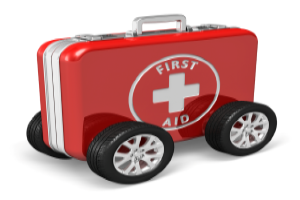Understandably no one wants to consider the possibility of witnessing an automobile accident or being in one themselves. Still, every time you get behind the wheel of your car, you must acknowledge that there is a chance that you could encounter an emergency situation. Having a stocked car first aid kit is one of the best ways to prepare for emergencies, whether they directly involve your vehicle or not.
1. A Container
You’ll want to put your first aid supplies in a box instead of a bag, which may become smashed in your car. Choose a container that is easy to access and allows you to view what is inside easily. While you do not need to purchase a box made specifically to be a first aid kit, you will need to make sure it can be quickly identified as a first aid kit if you are using something like a handled Tupperware bin. It is important to remember that you want your kit to be quickly recognizable. Red is an excellent color to use for the box as it is associated with first aid kits by most people.
2. First Aid Manual and Phone Numbers
The American Heart Association and Red Cross make laminated cards and pamphlets that illustrate how to perform first aid tasks such as performing CPR. These should have a place in your kit, alongside a laminated card that has the phone numbers for your emergency contacts, poison control, and your pet’s vet if you travel with any furry friends. If you have allergies, you’ll want these noted and displayed prominently as well.
3. Gloves and Personal Protective Equipment
You want to protect yourself from potentially dangerous materials in the event of an accident and gloves can help. A box of non-latex gloves should be included in your kit. Sturdy workman-style gloves are worth adding as well for events that involve jagged metal or broken glass.
4. Antiseptic Supplies
Having various ways to clean your hands or a wound will make you prepared for many situations. Antiseptic wipes are excellent for cleaning your hands, as is gel sanitizer. A bottle of saline solution can be used to wash out debris from a wound, and hydrogen peroxide is good for destroying germs. There are also numerous types of pain-free wound wash available on the market that allow you to flush and clean a mild wound such as road rash, cuts, and scrapes.
5. Wound Coverings and Bandaging Materials
Adhesive Band-Aids of various sizes are a first aid kit staple, as they are helpful in numerous emergency and non-emergency situations. Absorbent items such as gauze pads and gauze wrap should be kept in the first aid kit also, along with curved scissors and medical adhesive tape to allow you to wrap a wound that occurs on an extremity.
6. Ointments or Creams
Antibiotic creams allow you to prevent infection in wounds that are not serious enough to require professional medical care. Packing an antihistamine cream, such as hydrocortisone, will let you treat minor rashes and skin irritations such as bug bites. Vaseline can be used to treat cracking skin, and aloe vera is wise to have on hand for inflammation and sunburn.
7. Removal Objects
Tweezers are a first aid kit necessity. Q-tips and cotton balls can both be used to clean foreign items from wounds and apply creams.
8. Medications
If you take any prescription medications, it may be wise to have a day or two’s supply in your kit. Over-the-counter pain-relievers and anti-inflammatories are good to have in case of minor injuries or headaches on road trips.
Get Your Car Serviced Regularly at Our Frederick, MD Service Center
While you can’t always prevent accidents, you can be prepared to handle them to the best of your capabilities. Having a reliable vehicle is another excellent way to avoid ending up in an unwanted situation and that is why car maintenance is important to pay attention to regularly. Come over and see us at DARCARS Kia of Frederick for all your Kia services and repairs.





 Warranties include 10-year/100,000-mile powertrain and 5-year/60,000-mile basic. All warranties and roadside assistance are limited. See retailer for warranty details.
Warranties include 10-year/100,000-mile powertrain and 5-year/60,000-mile basic. All warranties and roadside assistance are limited. See retailer for warranty details.